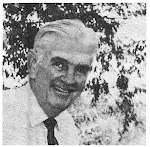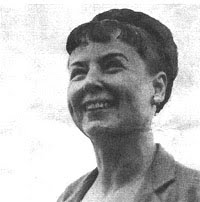It is, of course, a major discovery to find a previously unknown daVinci mural hidden behind a painting done years afterwards. But to bibliophiles who cherish Holling’s writing, painting and craftsmanship, it’s equally thrilling to find another copy of a long-lost book after 89 years.
Heather Heath in Livingston, Mont., found Sun and Smoke among donated books, then tracked down the Leslie Area Museum. (Photo by AP)
Heather Heath found Sun and Smoke: a Book of New Mexico Verse among donations to the Community Closet thrift shop in Livingston, Mont. She was the detective who set it aside for further examination, knowing there was something special about the limited edition work. She learned from the online auction site, eBay, that an estimated the value might be $235. This news began making the area papers. Associated Press writer Liz Kearney, chronicling the discovery, notes that Heath wondered at the inscription in the book: “To Florence and Dan, in memory of the 711 Ranch.” Who were Florence and Dan, had Holling ever visited Montana, and where was the 711 Ranch?
Heath then searched the Internet for information about Holling. (She may even have visited this blog.) From biographical information about Holling’s birthplace, she then tracked down Steve Hainstock, a past president and co-founder of the Leslie Area Museum in Michigan. He told her Sun and Smoke was the only book which the museum did not have. Heath stated in the AP story, “It was exciting to get this gentleman on the phone and hear him say ‘Wow!’”
In the spirit of the Community Closet’s policy of sharing with other nonprofits, Executive Director Caron Cooper secured permission to donate the book to the Leslie Area Museum. The folks in Leslie are eagerly awaiting an opportunity to see the verses and art Holling created over three-quarters of a century ago.
A story like this might have remained localized in Livingston, Mont., and Leslie, Mich. Happily, we live in a digital age, when search engines bring the world to our fingertips, communication links span vast distances, and the past is easily accessed by interested audiences everywhere. With so much sad news and tension in the world, it’s satisfying to know a writer like Holling Clancy Holling is still extolling the panorama that is America. And that one more view — of New Mexico in verse and art — has come to light.
Note: Sun and Smoke arrived in Leslie Friday, Mar. 23. Joan Hoffman said, “I went over to the Hainstocks’ house and saw it as the box was opened. The spine of the book is not good, so the book is in quite fragile condition. Steve plans to scan the pages so it won’t have to be handled further.”
Saturday, March 24, 2012
Monday, March 12, 2012
Breaking News: Pictures and Verse from the Past
A copy of Sun and Smoke: A Book of New Mexico has appeared! This is momentous news, as only 50 copies of Holling’s handmade book were published in 1923. Four copies are in university libraries and a fifth was sold last year by a rare books dealer.
On Feb. 8, Joan Hoffman learned that “a woman in Montana found a copy of Holling’s rare book in the thrift shop where she works.” A month later, Joan received a call and discovered “they’re donating the book to the Leslie Historical Museum. We were not sure we would get it, and certainly didn’t expect it to be an outright gift.” The book's delivery will be delayed at least until the local press is able to cover the story.
Sun and Smoke was created as a printing arts project when Holling was at the Art Institute of Chicago. The subject matter drew on the preceding months Holling had been in New Mexico. He had traveled extensively by horseback, took in the Taos art scene (and began appreciating color in his own painting), and worked at the ranch where he and Lucille Webster Holling were staying. He wrote the verses, carved wood blocks out of maple to illustrate and decorate the poems, and printed the 36-page book on hand-laid Fabriano paper from Italy. Both the printing and binding — culminating in a 6-1/2 by 10-1/4-inch book — were performed by Holling himself. This was truly an epic example of Holling’s craftsmanship.
Joan comments, “ I know Holling wanted to preserve his impressions of time spent in New Mexico, which he did in Sun and Smoke. I am anxious to see the poems and illustrations he used.”
We all are.
Labels:
Holling Clancy Holling,
rare books,
Sun and Smoke
Friday, March 2, 2012
No One Gets Mad Because the Writing Is Too Simple
In the introduction to Dr. Seuss’s The Bippolo Seed and Other Lost Stories, scholar Charles D. Cohen mentions a three-year-old who recited an entire Seuss story! The epiphany for author Theodor Geisel was that children absorb amazing volumes of information through their ears — lesser amounts through their eyes.
Key to Holling’s success was a Fog reading index of 6.9 — meaning that 91 percent of everyday words we use are more difficult. Only 5 percent of Holling’s words are foreign or complex. His choices average just 1.4 syllables per word. And, there are just 12.3 words per sentence.
It’s sometimes difficult to slide past polysyllabic environmental terms, or words in other languages. But Holling helps us in those instances, too. Tree in the Trail contains an amazing wealth of sidebar illustrations that explain history or define place names. In describing Coronado’s search for gold [chap. 5; unpaginated], he mentions an Indian town, Zuñi. The pronunciation — zoon-yee — is added parenthetically. Likewise, Santa Fe is spelled phonetically. Describing a Southwest trading and meeting place [chap. 9} he gives us Taos Pueblo and clarifies it as towse pweb-lo. This ease-of-entry is a secret to Holling’s enduring interest among young people and the home-schooled. Dr. Seuss, I think, would agree.
(A note of thanks for to E.J. Hirsch, Jr. for What Your Fifth Grader Needs to Know: Fundamentals of a Good Fifth Grade Education, from which these statistics are cited.)
Subscribe to:
Comments (Atom)











